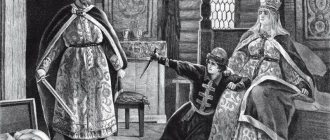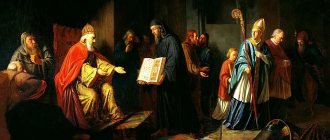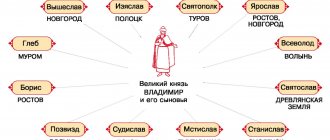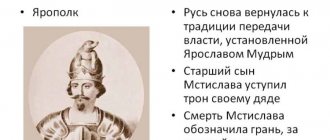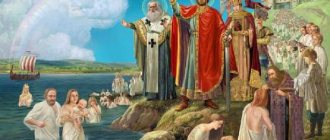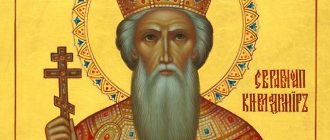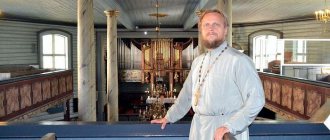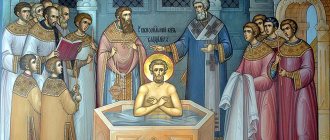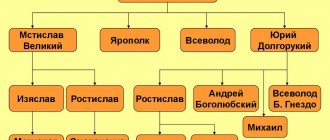During the absence of Grand Duke Svyatoslav, his sons ruled in Russia: Vladimir - in Novgorod, Yaropolk - in Kiev, Oleg - among the Drevlyans. After the death of Svyatoslav in 972, a struggle began between his sons for sole power in Rus'. Svyatoslav's eldest son Yaropolk, who reigned in Kyiv, decided to seize full power in the ancient Russian state and in 977 set out on a campaign against the Drevlyan lands of his brother Oleg. The reason for the war between the brothers was the murder by Oleg of one of Yaropolk’s friends while hunting.
Vladimir I (958-1015) - Grand Duke of Kiev, who in 988 converted to Christianity and began to baptize all of Kievan Rus. Portrait on the Ukrainian 1 hryvnia banknote. 1995
The brothers' squads met in battle near the Drevlyan city of Ovruch. Kyiv vigilantes forced their opponents to flee in panic. During the retreat, Oleg fell from his horse and was crushed to death by the hooves of his warriors' horses. Meanwhile, Yaropolk's younger brother Vladimir decided that he was not yet ready for war, and fled from Novgorod to Norway. Yaropolk occupied Novgorod without resistance. So all of Rus' came under the rule of the Kyiv prince.
Murder of the Polotsk princely family
In 980, Prince Vladimir returned from Norway to Russian soil with a well-trained Varangian army. He easily recaptured Novgorod, then went to the main city of the Krivichi, Polotsk, and took it by storm.
Dobrynya asks Rogvolod to marry his daughter Rogneda to Vladimir. Miniature from the “Facebook Chronicle”. Mid-16th century
In Polotsk it was not the Rurikovichs who reigned, but a certain prince Rogvolod, who came “from overseas”. He had a daughter, Rogneda, who was going to marry Yaropolk. Vladimir got ahead of his brother and wooed her. But Princess Rogneda refused him with the words: “I don’t want to take off Robichich’s shoes.” In those days, there was a wedding ceremony when the bride took off the groom's shoes.
And Robichich is the son of a slave. This word used by Rogneda suggests that Vladimir did not have a pure origin. In a situation where a ruler had a child on his side, who his mother was played a huge role. If she was a noble concubine, then this child was assigned a high status, and if she was a rootless servant, a slave, then her son stood lower than the other brothers.
Rogneda's assassination attempt on Vladimir. 985
Thus, Vladimir had a certain genealogical deficiency. He felt it one way or another (although his father, it seems, did not deprive him of anything while he was alive, and gave him Novgorod to reign). And at the same time, Vladimir was always in a position in the family, so to speak, a little noisy. But, on the other hand, this circumstance gave him, as often happens in such cases, additional strength and energy. This prompted Vladimir to organize the murder of his brother Yaropolk. The matter ended with the fact that of the three brothers, only Vladimir remained, who became the sole ruler.
Was Prince Vladimir's mother a slave?
The chronicle states that Vladimir’s mother was Malusha, Princess Olga’s housekeeper, that is, a maid who carried the mistress’s personal keys. In addition, the chronicle mentions her brother Dobrynya, the governor of Prince Svyatoslav. According to the laws of the then Rus', housekeepers, due to the special responsibility of their position, became personal slaves. At the age of three, Vladimir was taken in by Princess Olga. The origin of the prince played an important role in the episode when young Vladimir, while his older brother Yaropolk was still alive, decided to woo his bride Rogneda of Polotsk.
Ascension to the Kyiv throne
Yaropolk's warriors came under the command of Prince Vladimir Svyatoslavich. Thus he formed a fairly large army. Vladimir understood that it was time for him to part with the Varangian mercenaries, since he did not want the plunder of Kyiv. Before heading there, the prince sent the rest to Constantinople, to serve the Byzantine emperor, promising “mountains of gold.” The deal was successful for both parties, since Constantinople needed warriors to protect them from external and internal enemies.
Fratricide
After the capture of Polotsk, Vladimir’s army besieged Kyiv. The governor Yaropolk was bribed, who convinced the Grand Duke to first flee to the small town of Roden, and then come to his brother for negotiations. As soon as Yaropolk arrived at the enemy’s camp, the Varangians immediately pierced him with swords. Vladimir unhinderedly took the grand-ducal throne.
Death of Yaropolk. 980
In 988, Vladimir made a fateful decision: he first converted to Christianity himself, and then carried out the baptism of Rus'.
Church opinion
Patriarch of Moscow and All Rus' Kirill:
— In the year of the 1000th anniversary of the repose of the holy Equal-to-the-Apostles Prince Vladimir, we turn to the legacy that he left us. It is obvious that the main and most valuable meaning for us of the legacy of the Equal-to-the-Apostles prince is the religious meaning: this is the faith of Christ accepted by the people of Rus'. The legacy of any person - and especially such an outstanding one as Saint Vladimir - is not just some wealth, physical or spiritual, passed on to descendants. A legacy always contains a covenant and encourages descendants to action. Apparently, it was not only an aesthetic feeling that determined the choice in favor of the Eastern Church.
Question and answer
Day of the Baptism of Russia: the history of the holiday In this choice, the moral sense of the prince, the sense of national dignity and respect for his people could not but manifest itself. After all, it was in the Eastern Christian tradition that the complete preservation of national independence was assumed. Byzantium and Rus' interacted as equals with equals, and this was the most important condition for baptism. It is impossible to deny that by accepting Christianity, Rus' took a step towards the truth. However, baptism does not mean that our ancestors entered some special, elite community of peoples. Christ has no chosen people; He loves and waits for everyone. He loves those peoples who accepted Christianity in apostolic times, and those who were baptized during the time of Prince Vladimir, and those who heard the good news much later.
How did Rus' become Christian?
Since the baptism of Princess Olga, the number of Christians in Rus' has steadily increased, and the number of preachers of the new faith has also grown. Christianity at that time was professed by many Slavic peoples. Rus' had trade and political relations with the center of Christian Orthodoxy - Byzantium. Shortly before his baptism, Vladimir sent a squad of six thousand to Byzantium, with the help of which Emperor Vasily II defeated the rebellious commander Varda Phocas. In return, Vladimir demanded that the Byzantine princess Anna, the emperor’s sister, marry him. A positive answer would be a great political success for the prince. In response, the Byzantine ruler invited Vladimir to convert to Christianity. He agreed. The Greek priest Paul came to Kyiv and performed the baptism ceremony for the prince.
Arrival of the bishop in Kyiv. F. Bruni. 1839
However, Vasily II, who strengthened his power, did not send his sister to Kyiv. Indignant, Vladimir went on a campaign to the lands of Byzantium in Crimea, took the city of Chersonesos and, threatening a campaign against Constantinople, again demanded that the Byzantine emperor marry Anna to him. Vasily II was forced to yield. The marriage of Vladimir and Anna took place in Chersonesus.
After arriving in Kyiv, the priests baptized all Kiev residents on the Dnieper River (then baptismal ceremonies took place in other Russian cities), and Vladimir declared Christianity the state religion in Rus'.
Vladimir's acceptance of the Christian faith and his betrothal to Princess Anna. 988
The Christianization of Rus' lasted for several decades. Initially, the new faith established itself in the Dnieper region and some, primarily princely, cities. This process did not take place peacefully everywhere. Thus, in Novgorod there were bloody clashes between princely envoys and the local population. In northeastern Rus', preachers of the Word of God appeared only in the 11th century.
Who baptized Rus'?
Vladimir’s grandmother, Princess Olga, was the first to try to baptize Rus', but her son, Prince Svyatoslav, and his squad rejected the attempt, hoping to solve state problems by force of arms. As a result, Svyatoslav fell victim to his aggressive policy. True, there were many Christians in his circle - boyars and warriors. This led to Vladimir’s more cautious attitude towards his choice of faith. The new faith was supposed to raise the international prestige of the state and contribute to its unity.
Memory
For his greatest services, Vladimir Svyatoslavich (reign: 978-1015) in the creation of the Russian state was canonized by the Orthodox Church. In addition, he is revered by Catholics, since he lived before the Ecumenical Schism.
Every year on July 15 in Russia and in many other countries the day of his memory is celebrated. In Moscow, Kyiv, Sevastopol, Belgorod, etc. St. Monuments were erected to Vladimir, and a temple was built in his honor on the territory of Chersonesus.
Now you know the biography of Vladimir Svyatoslavich. It is difficult for a modern person to understand many of his actions. However, it cannot be denied that it was he who laid the foundations of Russian statehood and united the nation.
Vladimir's contribution to the history of Rus'
During the years of his reign (980-1015), Vladimir expanded and significantly strengthened the borders of the ancient Russian state. He conquered the Cherven-Przemysl land from Poland and conquered the Baltic tribes of the Yatvingians. And for defense against enemy attacks, he built many fortress cities in Rus'. Under the reign of Vladimir, the construction of stone defensive structures and Christian churches began. This was a period of economic and cultural growth of the state.
Monument to Vladimir the Great in Kyiv, erected in 1853.
Vladimir was the first in Rus' to begin minting gold and silver coins - zlatniks and silver coins. Before this, Byzantine and Arab gold and silver coins were used. Own money emphasized the independence and stable position of the prince as a Christian sovereign. On one side of the coins, the image of Christ was minted in order to designate the new religion of Rus', and on the other, the prince himself was depicted. Thanks to this, we know what Vladimir looked like - the owner of a massive chin, a small beard and a long mustache.
Zlatnik of Vladimir Svyatoslavich
Srebreniki of Vladimir Svyatoslavich
Questions on the topic
- What were the names of the sons of Prince Svyatoslav?
- Where did Yaropolk and Vladimir reign?
- How did Vladimir become the prince of Kyiv?
- What act of Prince Vladimir is considered the main one? What year did this happen?
- In what city did the marriage of Prince Vladimir with the Byzantine princess Anna take place?
Last years and death of Vladimir the Great
Prince Vladimir was going to change the principle of succession to the throne and bequeath power to his beloved son Boris. In the last years of Vladimir's life, Svyatopolk hatched a conspiracy against him, which was discovered and for some time Svyatopolk was imprisoned. Yaroslav stopped transferring tribute and church tithes from Novgorod to Kyiv, after which Vladimir decided to go with his squad against his son, but death did not allow him to do this.
When Vladimir died in the country residence Berestovo on July 15, 1015, Svyatopolk secretly carried out the body and, wrapping it in a carpet, took it to Kyiv to the Tithe Church of the Holy Mother of God. Despite the attempt to hide the death of Vladimir, the next morning countless people gathered in tears at the cathedral church.
Svyatopolk hides the death of Prince Vladimir (Fragment of chronicles)
“I died on Berestovoy, and hid, and, if only Svyatopolk was in Kyiv. At night, he built a platform between two cages, hid them in a carpet, hung the snakes on the ground and put them on the sleigh, and then placed them in the Holy Mother of God, which he himself created.”
